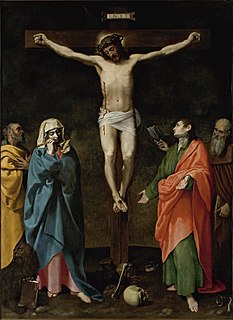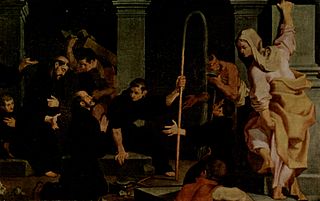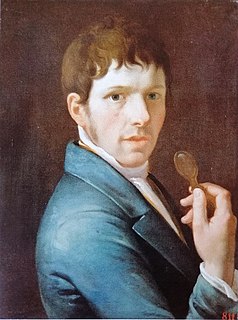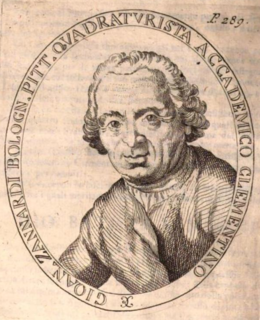Sources
- ↑ Dizionario universale di geografia, storia e biografia, compiled by Gustavo Strafforello and Emilio Treves, (1878) page 237.
Nicola Bertucci (c. 1710 – 2 January 1777) was an Italian painter of the late-Baroque or Rococo style, mainly painting figures in landscapes. He is also called l'Anconitano or Nicolo Bertuzzi.
Born in Ancona, Bertuzzi was a pupil of Vittorio María Bigari. [1] He painted a Life of the Blessed Franco (1753-4) for the Carmelite church in Medicina, in an effort where he collaborated with the specialist in quadratura, Vincenzo del Buono. He also painted Via Crucis canvases (1753) for churches in Ancona. He mainly worked in Bologna, including 14 small paintings for the Via Crucis of the church of the Hospital of the Church of San Biagio. After 1753, often collaborated with Carlo Lodi.
In the Pinacoteca civica of Forlì, there are: Battle scenes and Landscape with army over bridge'.
In 1732, he enrolled the Accademia Clementina, and In 1734–5, he won the first prize for an architectural project; he soon joined that institution as a member in 1751, and later, as a director. He died in Bologna.

Giovanni Francesco Barbieri, better known as Guercino, or il Guercino[ɡwerˈtʃiːno], was an Italian Baroque painter and draftsman from Cento in the Emilia region, who was active in Rome and Bologna. The vigorous naturalism of his early manner contrasts with the classical equilibrium of his later works. His many drawings are noted for their luminosity and lively style.

Pellegrino Tibaldi, also known as Pellegrino di Tibaldo de Pellegrini, was an Italian mannerist architect, sculptor, and mural painter.

Jean-Baptiste Oudry was a French Rococo painter, engraver, and tapestry designer. He is particularly well known for his naturalistic pictures of animals and his hunt pieces depicting game.

Bartolomeo Cesi was an Italian painter and draftsman of the Bolognese School. He made easel paintings as well as frescoes. He is known mainly for his religious paintings but he also painted portraits and mythological scenes.

Lorenzo Pasinelli was an Italian painter active mainly in Bologna during the late Baroque period.

Andrea Lilio was an Italian painter born in Ancona, hence he also is known as L'Anconitano.
Events from the year 1699 in art.

Pietro Fancelli was an Italian painter and set-designer.

Carlo Lodi was an Italian painter of the late-Baroque period in Bologna, mainly painting landscapes.
Roberto Rasinelli was an Italian painter, mainly painting landscapes and genre scenes, in oil and watercolor. He often painted his landscapes on site, outdoors.

Giuseppe Camino (1818-1890) was an Italian painter, mainly of landscapes and vedute.

Giovanni Zanardi was an Italian painter of quadratura during the late Baroque period.

Cesare Giuseppe Mazzoni or Gioseffo Mazzoni was an Italian painter, active in a late-Baroque style.
Luca Antonio Bistega or Luca Bestega was an Italian painter of quadratura, active mainly in Bologna, Italy.

Michele Antonio Milocco was an Italian painter, of the late-Baroque period.
Abate Francesco Antonio Chiozzi was an Italian painter and Franciscan cleric, active mainly in Casalmaggiore, Italy.
Pietro Scandellari (1711–1789) was an Italian painter and scenic designer.
Giuseppe Antonio Luchi, also known as il Diecimino, was an Italian painter.
Antonio Francesco Peruzzini was an Italian painter of the Baroque period.
Vincenzo Martinelli was an Italian painter mainly painting landscapes both on canvas and fresco, mainly in his native Bologna.